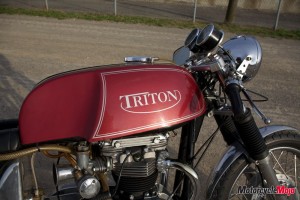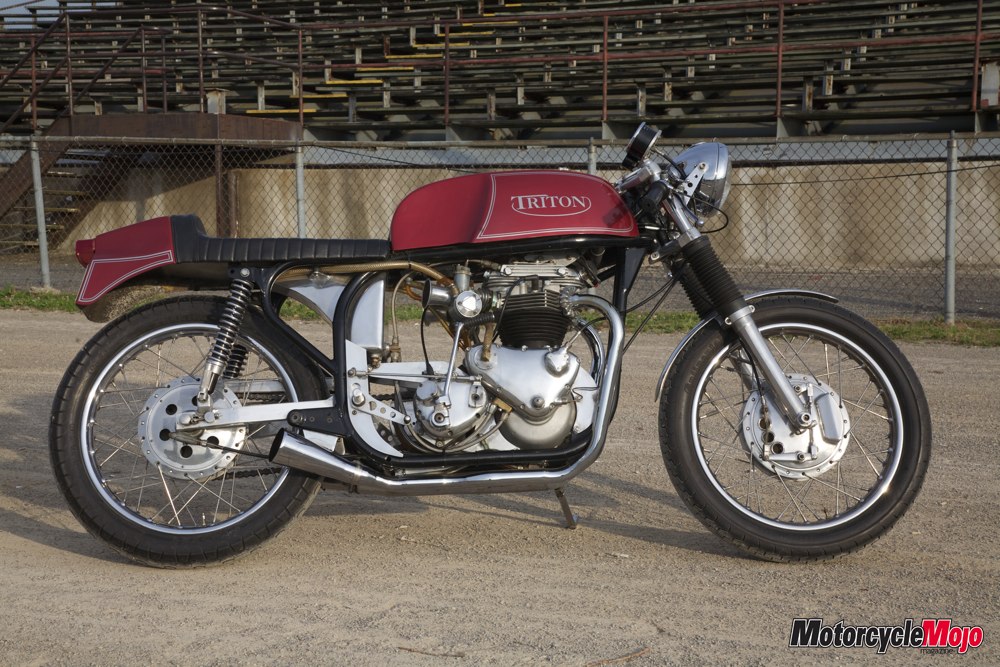England in the ’50s and ’60s was an exciting time for motorcyclists. Developments in the British motorcycle industry included, most notably, Triumph’s reputation as a strong runner in the racing theatre, and Norton’s reputation as the best-handling motorcycle on the road, or on the track, after the introduction of the featherbed frame.
It’s no wonder, then, that the builders of specials and café racers found the ultimate ton-up road machine by blending the best with the best – merging the driveline of the Triumph with the frame of the Norton. The result was the Triton.
Growing up in England at the height of the Mods and Rockers era, Ray Roberts always had a thing for the Triton. His brother and all of Ray’s friends were Mods, so it might have been his love of the Triton that directed Ray to the Rocker side of the fence. With a smile and an enthusiastic English accent, Ray said, “The Triton was a classic from before my time, from the fifties and sixties, but I always wanted one.”
 A few years after immigrating to Canada, Ray went back to Britain to pick up parts to build his own Triton, and he proceeded to race it in the vintage class for a few seasons.
A few years after immigrating to Canada, Ray went back to Britain to pick up parts to build his own Triton, and he proceeded to race it in the vintage class for a few seasons.
However, one Triton is never enough. A race bike is fine for the track, but not so good for road duty. Ray, having some extra parts lying around, got in touch with his good friend and multitalented tinker, Peter Conway. Ray donated a slim-line featherbed frame, some engine cases and the seat, and also had some input into the build. “I helped with a few things, but Peter Conway built the bike,” Ray said. “There’s nothing this guy can’t do. We used to call him MacGyver.”
One look at this Triton special and it’s obvious there is a plethora of exquisitely crafted handmade pieces throughout. Making the engine mounting plates needed to graft the Triumph powerplant to the slimline frame is one thing, but providing the exhaust camshaft with a pressurized oil feed takes some real engineering ingenuity.
Peter made a hardwood form of the fuel tank, and once happy with the design, he then hand-shaped the aluminum tank over it and welded it up.
The more Ray talked of his friend’s talents and accomplishments, the more excited he got. “He made the inner chain case and designed a primary chain oiling system that is fed with engine oil. At a certain level, the oil is directed back into the engine’s sump. He even designed and made the oil tank to have a hidden spin-on filter, which is accessible under the seat.” Ray continued, “Peter felt the oil pump (piston-plunger type) was cavitating and not producing enough oil pressure, so he ported the pump as if it was a 2-stroke, and now the bike’s oil pressure is at 80 psi at idle, and it runs on 100% synthetic oil.” Running synthetic oil on a vintage bike is something Ray would never do for fear of it leaking out of every seal and seam, but he says this engine is oil tight and a very strong runner.
Peter handcrafted the aluminum swingarm, which pivots on needle bearings, and even went to all the trouble of making the clip-on bars. Ray said in disbelief, “They can be bought for around $39, but he made these. There’s a lot of work to make those.”
The Triton runs a competition magneto and uses a Mighty Max battery eliminator for the lighting and electrical system, cutting out the added weight of a cumbersome battery.
In order to fine-tune the Triton, Peter built a “rolling road” with a pneumatically controlled brake caliper and disc so he could get the bike up to speed under load while fiddling with the carburetor’s handmade adjustable main jets. Once the bike was tuned, the rolling road was never used again.
The only work Ray had to do after assuming possession of the Triton was to move the footpegs a bit forward, as the original rearsets were too far back to be comfortable.
Ray hasn’t given up on his first Triton, either. After a few years on the track, it’s looking a little sad and needs a facelift, which it will get as he massages it back to road trim.
| Owner: | Ray Roberts |
| Make: | Triton |
| Model: | Café Racer |
| Builder: | Peter Conway |
| Time to Build: | 2 years |
| Engine | |
| Year: | 1960 |
| Builder: | Peter Conway |
| Displacement: | 650 cc |
| Cases: | T120 Bonneville |
| Head: | Late ’60s 9-stud twin carb |
| Lower End: | T120 Bonneville |
| Carburetor: | 1-1/8” monoblocks with extended float bowls and adjustable main jets |
| Air Cleaner: | None, Velocity stacks |
| Ignition: | |
| BTH competition Magneto | |
| Exhaust: | Hand built |
| Transmission | |
| Year: | Early ’60s 4-speed Norton |
| Builder: | Peter Conway |
| Clutch: | Norton |
| Primary Drive: | Single row chain |
| Frame | |
| Year: | 1960 |
| Type: | Norton slim-line featherbed |
| Shocks: | Standard Girling type |
| Modifications: | None |
| Front End | |
| Year: | Mid-1970s |
| Builder: | Can-Am |
| Type: | 35 mm |
| Triple Trees: | Can-Am |
| Painting: | Frame painted in Emron black |
| Restoration: | 1997 |
| Wheels | |
| Front Size: | |
| Builder/Manufacturer: | Standard British chrome WM2 with Norton Atlas hub |
| Tire Make and Size: | Continental Conti-Blitz 3.25-19 |
| Rear Size: | |
| Builder/Manufacturer: | Standard British chrome WM3 with Norton Atlas hub |
| Tire Make and Size: | Pirelli Phanton 3.50-19 |
| Essentials | |
| Gas Tank: | Homemade aluminum painted candy-apple red |
| Oil Tank: | Homemade aluminum with built-in, spin-on cartridge oil filter |
| Fenders: | Front homemade aluminum, rear fender built into seat |
| Seat: | Dresda |
| Handlebars: | Homemade clip-ons |
| Headlight: | Standard 7 inch Lucas |
| Taillight: | Lucas built into fender/seat |

















